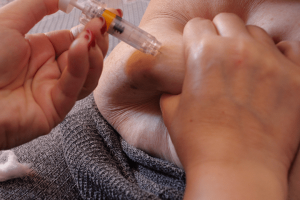Thailand IVF Gender Selection Prices
What is IVF?
IVF treatment is the treatment methods preferred by couples to have a baby. In IVF treatment, reproductive cells taken from couples of two different sexes are fertilized in a laboratory environment. As a result of fertilization, the gamete formed is released into the uterus of the woman. Thus, the pregnancy process begins.
What Is Sex Selection With IVF?
Gender selection is very often preferred with IVF treatments. Unlike normal IVF treatment, Gender Selection is possible with only one test application. Unlike IVF;
Embryos formed as a result of fertilization of sperm and egg are subjected to the test. As a result of the test, the preferred gender of the mother and father is placed in the womb and pregnancy begins. Thus, the desired gender embryo is selected before it is placed in the mother’s womb and pregnancy is launched.

Reasons For Gender Selection During IVF
There are many reasons why a couple or person chooses gender. However, intended parents often preferred to use gender selection for ‘Family Balance’.
Simply put, family balance means that if you’ve always wanted a girl but only have boys, the intended parents can choose gender during IVF to ensure you’re raising a baby girl.
Additionally, intended parents prefer gender selection if they are at risk of transferring a sex-based genetically transmitted disease. In this scenario, gender selection gives prospective parents the chance to have a baby boy or girl, depending on the type of disorder they can avoid during the IVF procedure.
Other events may include a couple who have lost a child and wish to have another of the same sex, or the intended parents may be more spiritually equipped to parent from one gender to the other.
There are deeply personal reasons for wanting to choose a gender with IVF, and we aim to respect your decision. If you’re curious about gender selection and think it’s a good option for your needs, we can discuss it during the consultation process.
Gender selection is an incredible service science makes possible and can help prospective parents feel more prepared to raise their future children. However, this decision requires careful consideration as it entails a higher cost and can eventually lead to regret if a parent chooses to later find out their child’s gender naturally.
Preimplantation Genetic Testing (PGT)
In fact, Preimplantation genetic testing (PGD), actually, this test is used with the latest technology to identify genetic diseases and features in embryos. Therefore, the main purpose of PGD is for your doctor to be able to select embryos that do not have certain chromosomal abnormalities and transfer them to the uterus. In short, PGD is actually to identify the genetic diseases that exist in the embryo and to choose the one with the better gene.
This test offers patients an opportunity to reduce the likelihood of a genetic disease in their child before pregnancy. But of course, it is possible to determine the gender of your baby with the same test. Therefore, this test is also necessary for gender selection in IVF. After determining the preferred gender of the patients with this test, this embryo is placed in the uterus.

How The Process Works
Thailand IVF gender selection works within a certain plan. The stages of this treatment are as follows;
- Stage: First Examination and Evaluation of the Couple
- Stage: Stimulation of the Ovaries (Ovulation Induction)
- Stage: Collecting the Eggs
- Stage : Ensuring Fertilization with Microinjection Method (ICSI) or Classic IVF Treatment
- Stage: Embryo Transfer to the Expectant Mother
- Stage: Pregnancy Test
Thailand IVF Gender Selection Steps
Since choosing the right gender requires IVF, which is a very intense process in itself, it is important to understand, at least at a basic level, what the whole process will entail. In general IVF has 4 main steps:
- Ovarian Stimulation: The woman takes hormone-based drugs (as opposed to what is often done) to make many high-quality fully developed eggs.
- Egg Retrieval: Removes eggs from the ovaries.
- Embryology Laboratory: Fertilization of eggs, 3-7 days embryo development
- Embryo Transfer: Embryo transfer is the process of placing an embryo back into the womb of its intended parents.
Because sex selection requires additional embryonic testing (results take several days to arrive), it not only requires additional steps specific to testing embryos, but also requires two “treatment cycles”. One involves the making and testing of embryos, the other a Frozen Embryo Transfer Cycle involving preparation of the uterus for insertion and the FET itself.

Stage 1: Embryo Construction and Test Cycle
This part of the treatment is relatively similar to an embryo freezing treatment, in which embryos are made through IVF and frozen immediately afterward. Of course, before freezing, a biopsy is done and sent to a lab for checking.
Ovarian Stimulation:
In the same way as above, the woman takes hormone-based drugs to make a number of mature, high-quality eggs. These stimulant drugs are usually in the 2nd-4th phase of a woman’s natural grain cycle. It starts on days and is taken for 10 days. The idea is that more eggs = more embryos = more embryos of the desired sex = an embryo of the desired sex is more likely to have a live birth.
Egg Collection:
Again, egg retrieval is the surgical procedure in which eggs are collected from the ovaries. Eggs are delivered to the patient 12 days after the simulation drugs. Although it may sound scary, it does not require incisions and stitches and is a fairly easy procedure. Often does not use general anesthesia (requires intubation and significant recovery time).
Instead, the patient is given a short-term drowsiness called MAC anesthesia. This is called Sedation. During the procedure, an aspiration needle is directed from the vagina to the follicles in the ovaries under ultrasound guidance. After being taken from the ovaries, test tubes containing follicular fluid and mature eggs are immediately taken to the embryology laboratory.
Embryology Laboratory: The steps that take place in the embryology laboratory during gender selection can be divided into 5 main steps:
Isolation: After the eggs enter the laboratory, an embryologist will probe the follicular fluid and isolate any eggs found. It will immediately be placed in nutrient media that mimics the fallopian tube environment.
Fertilization: Approximately 4 hours after collection, embryos will be fertilized using ICSI or conventional insemination methods.
Embryo Development: After fertilization, embryos will grow in the laboratory for 5-7 days. In a standard IVF cycle it is possible to transfer embryos after only 3 days (when in the cleavage stage of development), genetic testing can only be done on blastocyst embryos that usually develop on day 5 (which can only develop a little later).
Embryo Biopsy: Once at the blastocyst stage, the embryo consists of two different types of embryonic tissue. One of these cell groups will be the fetus and the other will be the placenta. The biopsy is done using a highly specialized and focused laser that removes a small number (usually 3-6 cells) from a group of cells that will develop into the placenta (called the trophectoderm). These cells are then labeled, processed and sent to a third-party genetics laboratory in a suitable format for analysis.
Genetic Test: Actual genetic control is performed by a third-party genetics laboratory using a technique known as Preimplantation Genetic Testing for Aneuploidy (PGT-A), which analyzes the number and variety of chromosomes in each cell. With the chromosome analysis performed, a cluster of cells related to a particular embryo will be labeled as XY or XX along with other basic information regarding the number of chromosomes in each cell. With this information, the intended parents and fertility clinic can now be prepared for a Frozen Embryo Transfer using a thawed embryo of the desired sex.

Stage 2: Frozen Embryo Transfer Using an Embryo of the Desired Sex
Frozen embryo transfer is much simpler than the first stage of the IVF cycle and involves only two main steps:
- Development of the Uterine Lining: When transferring an IVF embryo, it is important to ensure that the uterus is optimally prepared for the embryo to implant into the endometrial lining. Although it is possible to do a natural FET cycle with no drugs taken, it is highly recommended from a medical point of view that the woman takes Estrogen and Progesterone for a certain period of time before and after the embryo transfer.
- Frozen Embryo Transfer: For an embryo transfer using genetically controlled embryos for sex selection, one of the embryos determined to be the desired sex is removed from cryo tanks containing liquid nitrogen and thawed. Once thawed, the embryos will be loaded into a medical grade insertion catheter, passed through the vagina and cervix, and expelled into the uterus. The intended parent is now (until proven otherwise) pregnant with an embryo that will develop into a fetus and child of the sex of their choice.
Which Country Is The Best For Thailand IVF Gender Selection?
The success rates of IVF treatments are very important. Couples should choose highly successful countries and highly successful hospitals to receive treatment. Otherwise, negative results of the treatments are possible. On the other hand, IVF prices must be affordable. Finally, receiving Thailand IVF gender selection treatment is not legal in every country.
In this case, couples should choose cost-effective countries where Thailand IVF gender selection is legal and successful IVF treatments can be obtained. For this reason, Thailand IVF gender selection will be an extremely good choice. Thailand IVF gender selection will allow you to receive treatments that are legally possible, cost effective and highly successful.
Thailand IVF Gender Selection
Thailand IVF gender preference is preferred quite frequently. Gender selection in IVF treatments is legal in Thailand. In countries where gender IVF preference is not legal, although some clinics may do this secretly, the prices will be quite high and you will not be able to claim your rights as a result of an unsuccessful treatment. Therefore Thailand is a good country for IVF Gender preference. You can also get a price for Thailand IVF Gender Selection Treatments, and get a treatment plan by contacting us.
Thailand IVF Gender Selection Prices
Thailand IVF treatment prices are highly variable. Patients should be aware that treatment prices will also vary between clinics. Therefore, patients need to choose a good clinic for treatment and make an important decision. Because Thailand IVF treatment prices are affordable and patients should not overpay, thinking that they can get better treatment.
This will only cause you to spend more money. You can consider getting treatment from a clinic with high success rates at affordable prices. Prices are starting from 3,200 € on average. As we provide treatment with the best price guarantee, you can get detailed information by sending us a message.














